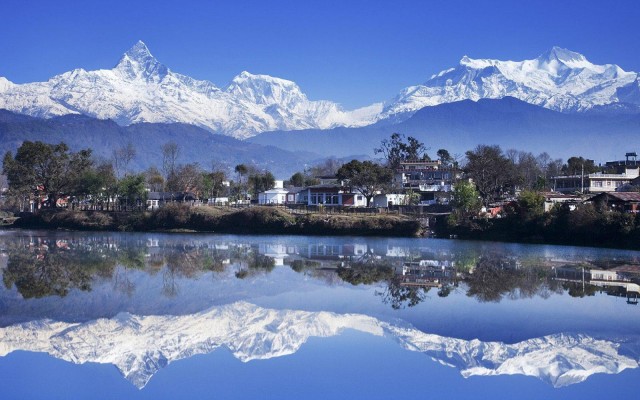Kashmir
KASHMIR IS THE name given to the Vale of Kashmir, a valley situated on the Jhelum River between the Pir Panjal range and the main range of the HIMALAYAS. By extension, the name is used to refer to the Indian state of Jammu and Kashmir and to a portion of the old preindependence territory that included what is now called Northern Areas and Azad (Free) Kashmir in PAKISTAN. In addition, INDIA claims a 14,500-square-mile (37,554-square-km) section of the Tibetan plateau, “Aksai Chin,” as part of the old state of Kashmir. Kashmir was also a state under British soveriegnty until 1947 when the Hindu maharaja of the largely Muslim state attempted to obtain a degree of independence for his land by not joining Hindu India or Muslim Pakistan. The delay led to disputed territory between the two powers. The Indian government claimed that the Hindu ruler of Kashmir state had signed an Instrument of Accession to India, although the original document has never been seen, nor is there any evidence to indicate that the maharaja signed the document on the day cited, as he was being driven from Srinagar to Jammu. The state fell into outside hands, once again having been under the rule of the Moghuls and the Sikhs in previous centuries. Although the United Nations agreed to the suggestion of a plebiscite to which India also agreed, no such vote has ever taken place.

India has claimed territory, the former Gilgit Agency and Baltistan, that is now under Pakistani control and known as the Northern Areas. A small portion of this agency in the extreme north and lying in the watershed draining into CHINA was deeded to China by Pakistan in 1964. At no time did Gilgit Agency come under direct Kashmir rule, because the British kept a civil and military delegation in the agency prior to independence. Because of the continuing disputes of jurisdiction of Kashmir, Pakistan has agitated for a plebiscite, which now seems remote. Armed conflict by India with China and Pakistan has resulted in small wars in 1962 with China and in 1965 and 1971 with Pakistan. A transitory border, “The Line of Control,” was established but another dispute broke out in 1984 when Pakistan issued permits to tourists into territory that India claimed as Kashmir India territory. This dispute revolved around the Siachen glacier, the headwaters for the Nubra River flowing into the Shyok River, a tributary of the Indus.
This continued territorial dispute mars the attributes of Kashmir in its several guises today. Geographically, Jammu is in the Punjab lowlands and is Hindu or Sikh. The Vale of Kashmir is almost all Muslim today, the Hindu castes having left. Territorially, the largest area is Ladakh in the trans-Himalaya Tibetan plateau, where local culture is similar to that of Tibet but where there are a substantial number of Muslims, both Sunni and Shia. These people formerly conducted caravan trade across the infamous “Five Passes” route, that is, five passes over 18,000 ft (5,500 m), on the route from Leh in Ladakh to Sainju Bazaar down on the edge of the Takla Makan Desert bowl of XINJIANG province in western China. This lucrative trading route was the reason for the prosperity of old Kashmir. Its geography created a passland, that is, a state through which passes were essential for its commercial existence. The route was dangerous with robbers from Shimshall in the Hunza area pillaging pack ponies and Bactrian camels who often died from lardug, high-altitude pulmonary edema. The hybrid Buddhist-Muslim trader community in Leh and along the trading route ensured the viability of the caravans. Between Srinagar and Leh, the Zoji pass was snowed in for six months of the year, thereby disrupting traffic. Another route from Srinagar went north over the Burzil pass down the Astor valley, over the Indus, and north to Gilgit. Because of the narrow defiles north of Gilgit and Hunza and over the crest of the Karakorum range little interregional trade was carried over this route. Transhumants of sheep and goats still migrate seasonally in the Pir Panjal and Himalaya mountains.
The Vale of Kashmir was once a major tourist destination, with houseboats on the Dal and Wular lakes nestling below high mountains with local products for sale. Many Indian films customarily showed Kashmir scenes. Trout fishing on the Liddar River on the Hindu pilgrimage route beyond Pahlgam was famous. Traditional woodworking, silk making, and wool products were highly sought. Agriculture is marginal, with rice, maize, peas, and beans widespread. The cultivation of saffron is a local specialty. Basic foodstuffs are imported from the Punjab. Stone fruits, cherries, peaches, apricots, and walnuts and almonds are exported to the plains of India through the Banihal tunnel, the main supply route from the Vale to India. Wildlife has suffered extreme depredation in recent years because of the prevalence of military weapons among divisive political factions. The noble sambar deer is severely depleted; ibex wild goat and urial wild sheep and blue sheep still remain in places in Ladakh, although markhor seems to have disappeared. Brown bear and Himalayan black bear now have their ranges severely
curtailed. The elusive snow leopard still exists in the Markha valley in Ladakh, where a major conservation effort is under way.
In the past three decades, language has changed significantly. Kashmiri, an Indo-Aryan hill language cognate with the hill languages spoken through northern Pakistan to Pashai in Kabul Kohestan in Afghanistan, reports a decline in the number of speakers. Bazaar languages, Punjabi in the Vale of Kashmir, like Pashto in northern Pakistan and Farsi in Kabul Kohestan, have smothered regional languages in everyday usage. English schools are ubiquitous. Two villages in Ladakh sitting on the “Line of Control,” Dah and Hannu, retain pre-Islamic, pre-Buddhist cultural celebrations to this day. Nineteenth-century linguists referred to these villages, and others, as Dardic, although there is no validity to this term today. Eurocentric myths about the “Dards” being the true Aryans still surface today in Ladakh.